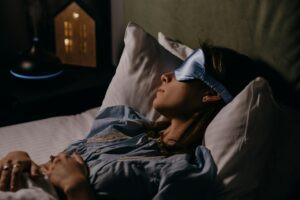It’s 5 PM on a Tuesday in October and you can barely keep your eyes open. By 10 PM, when you finally crawl into bed, you’re wide awake.
If that sounds familiar, you’re not alone. Many people struggle with sleep when the seasons shift. As a therapist who specializes in sleep, I see this happen every year.
Fall insomnia is incredibly common, and there’s actually a perfectly logical reason your sleep seems to fall apart right around the time the leaves start changing.
Let me explain what’s happening to your brain, and what you can do about it.
Here’s What’s Really Going On
Your Body Is Just Doing What It’s Supposed to Do
That 5 PM crash? It’s not because you had too much coffee or didn’t sleep well last night (though those don’t help). Your brain is responding exactly the way it should when the sun starts setting earlier.
As soon as it gets darker outside, your body starts releasing melatonin, the hormone that makes you sleepy. So when the sun goes down at 6 PM instead of 8 PM, your brain thinks it’s bedtime two hours earlier than usual.
But here’s where it gets tricky. Most of us can’t actually go to bed at 6 PM. We’ve got dinner to make, kids to help with homework, shows to catch up on. So we push through that sleepiness with bright lights and stimulating activities.
Why You Get That Annoying “Second Wind”
By the time you finally get to bed, your internal clock is confused. It started the whole sleep process hours ago, but now you’re telling it to wait up.
This is where that second wind comes from. Your brain is caught between two competing signals. Part of your brain is still trying to sleep from earlier, but the other part is now alert because you’ve been fighting the sleepiness for hours.
And when daylight savings hits? Forget about it. Your poor circadian rhythm is already trying to adjust to shorter days, and then we throw in an abrupt one-hour shift just to make things even harder.
The Fall Sleep Traps (You’re Probably Falling Into at Least One)
The “Cozy Morning” Trap
I get it. When it’s cold and dark at 6 AM, the last thing you want to do is leave your warm bed. But hitting snooze repeatedly or staying under the covers way past your usual wake time actually makes your sleep worse.
Your brain needs consistent wake-up signals to keep your internal clock running smoothly. When you sleep in on weekends or linger in bed because it’s dark out, you’re giving your brain mixed signals, making it harder to keep a steady rhythm.
The “Indoor Hibernation” Trap
Shorter days tend to mean more time spent indoors. Less sunlight exposure (especially in the morning) means weaker sleep signals throughout the day. Add in less physical activity because you’re not walking outside as much, and you’ve got a recipe for sleep problems.
Think about it: if you’re not building up enough “sleep pressure” during the day, your body won’t be craving sleep at bedtime.
The “Fighting the Sleepy” Trap
That 5 PM drowsiness isn’t something to push through with espresso and overstimulating shows on TV. When you fight against your natural sleepiness, you often end up more alert later when you actually want to sleep. Pushing past early evening drowsiness confuses your internal clock. The brain interprets the extra light and activity as a cue to stay awake, which delays your natural sleep window.
What Actually Helps (Without Turning Your Life Upside Down)
Work With the Sleepiness, Not Against It
Instead of chugging coffee when you feel drowsy early in the evening, use that time for quieter activities. Read a book, do some gentle stretching, or prep for the next day. Save the stimulating stuff (intense work calls, heavy exercise) for earlier in the day.
You don’t have to go to bed at 6 PM, but you also don’t have to fight against your natural rhythms.
Get Morning Sunlight
The single most important thing you can do for fall sleep problems? Get outside within an hour of waking up, even if it’s cloudy.
I know, I know—it’s dark and cold and the last thing you want to do is step outside. But even 10 minutes of natural light (yes, even through clouds) sends stronger signals to your brain than any amount of indoor lighting.
If you absolutely can’t get outside, at least position yourself near a big window while you have your morning coffee, or consider using a lightbox.
| Struggling to nail down the perfect-for-you bedtime? Our Sleep Calculator takes the guesswork out of timing. Answer a few quick questions about when you naturally get sleepy and when you need to wake up, and we’ll figure out your ideal sleep schedule. No more lying awake wondering if you’re going to bed too early or too late. |
Make Small Adjustments, Not Dramatic Changes
I see this mistake all the time: someone feels sleepy at 5 PM, so they decide to go to bed at 8 PM instead of their usual 11 PM. That’s a three-hour jump, and your brain is going to push back.
If you want to shift your bedtime earlier (which might make sense in the fall), do it gradually. Try something like 15-30 minutes earlier each week. Your internal clock needs time to adjust, not abrupt changes.
Keep Your Wake Time Steady
This is the anchor of good sleep: waking up at roughly the same time every day, including weekends. I know it’s tempting to sleep in on Saturday morning, but that just makes Monday mornings even worse.
Your wake time is actually more important than your bedtime for keeping your internal clock stable.
When Fall Sleep Problems Become Something More
Some sleep shifts during seasonal transitions are totally normal. But if you’re dealing with insomnia that lasts more than a few weeks, or if you’re so exhausted during the day that you can barely function, it might be time to get some help.
In the fall, pay attention to whether you’re still having these problems after your body has had time to adjust to daylight savings (usually 2-4 weeks). If you’re still lying awake for hours every night, or if you’re feeling really depressed or anxious along with the sleep issues, those are signs that you could benefit from talking to someone who specializes in sleep problems.
The difference between normal seasonal adjustment and something that needs professional attention? Normal adjustment is annoying but manageable. You might be tired, but you can still get through your day. If your sleep problems are interfering with work, relationships, or daily activities, that’s when you know it’s time to reach out.
The Bottom Line
Your sleep feels out of sync because your brain is doing exactly what evolution programmed it to do when the days get shorter. You’re not broken, and you’re not imagining it.
The trick is working with these changes instead of fighting them. Pick one or two things from this list that seem doable—maybe it’s getting outside for 10 minutes each morning, or doing some reading instead of scrolling your phone when you feel sleepy early.
Small changes add up. You don’t have to overhaul your entire life to sleep better during the darker months.
Ready to Stop Guessing About Your Sleep?
If you want to move beyond basic sleep tips, grab my free guide: Five Things to Avoid if You Want Better Sleep. It covers the most common mistakes people make and gives you practical alternatives that actually work.
Your sleep matters, especially when everything else feels harder during the shorter days. You deserve to feel rested, and with a few small adjustments, you can get there.




